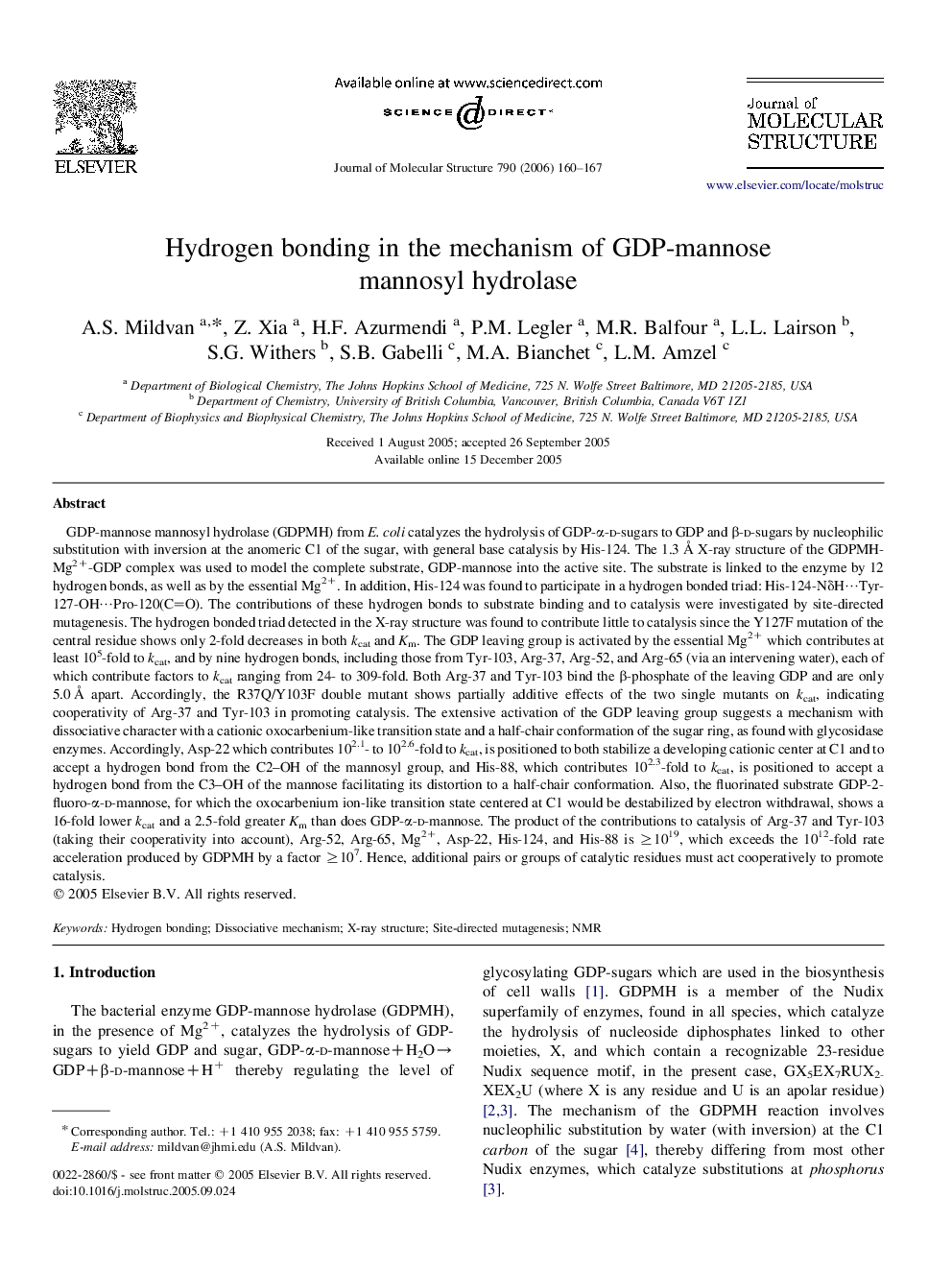| Article ID | Journal | Published Year | Pages | File Type |
|---|---|---|---|---|
| 1404693 | Journal of Molecular Structure | 2006 | 8 Pages |
Abstract
GDP-mannose mannosyl hydrolase (GDPMH) from E. coli catalyzes the hydrolysis of GDP-α-d-sugars to GDP and β-d-sugars by nucleophilic substitution with inversion at the anomeric C1 of the sugar, with general base catalysis by His-124. The 1.3 Ã
X-ray structure of the GDPMH-Mg2+-GDP complex was used to model the complete substrate, GDP-mannose into the active site. The substrate is linked to the enzyme by 12 hydrogen bonds, as well as by the essential Mg2+. In addition, His-124 was found to participate in a hydrogen bonded triad: His-124-NδHâ¯Tyr-127-OHâ¯Pro-120(CO). The contributions of these hydrogen bonds to substrate binding and to catalysis were investigated by site-directed mutagenesis. The hydrogen bonded triad detected in the X-ray structure was found to contribute little to catalysis since the Y127F mutation of the central residue shows only 2-fold decreases in both kcat and Km. The GDP leaving group is activated by the essential Mg2+ which contributes at least 105-fold to kcat, and by nine hydrogen bonds, including those from Tyr-103, Arg-37, Arg-52, and Arg-65 (via an intervening water), each of which contribute factors to kcat ranging from 24- to 309-fold. Both Arg-37 and Tyr-103 bind the β-phosphate of the leaving GDP and are only 5.0 Ã
apart. Accordingly, the R37Q/Y103F double mutant shows partially additive effects of the two single mutants on kcat, indicating cooperativity of Arg-37 and Tyr-103 in promoting catalysis. The extensive activation of the GDP leaving group suggests a mechanism with dissociative character with a cationic oxocarbenium-like transition state and a half-chair conformation of the sugar ring, as found with glycosidase enzymes. Accordingly, Asp-22 which contributes 102.1- to 102.6-fold to kcat, is positioned to both stabilize a developing cationic center at C1 and to accept a hydrogen bond from the C2-OH of the mannosyl group, and His-88, which contributes 102.3-fold to kcat, is positioned to accept a hydrogen bond from the C3-OH of the mannose facilitating its distortion to a half-chair conformation. Also, the fluorinated substrate GDP-2-fluoro-α-d-mannose, for which the oxocarbenium ion-like transition state centered at C1 would be destabilized by electron withdrawal, shows a 16-fold lower kcat and a 2.5-fold greater Km than does GDP-α-d-mannose. The product of the contributions to catalysis of Arg-37 and Tyr-103 (taking their cooperativity into account), Arg-52, Arg-65, Mg2+, Asp-22, His-124, and His-88 is â¥1019, which exceeds the 1012-fold rate acceleration produced by GDPMH by a factor â¥107. Hence, additional pairs or groups of catalytic residues must act cooperatively to promote catalysis.
Related Topics
Physical Sciences and Engineering
Chemistry
Organic Chemistry
Authors
A.S. Mildvan, Z. Xia, H.F. Azurmendi, P.M. Legler, M.R. Balfour, L.L. Lairson, S.G. Withers, S.B. Gabelli, M.A. Bianchet, L.M. Amzel,
